As the seat of Fort Worth in the Dallas-Fort Worth metroplex, Tarrant County is one of the largest counties in Texas. With both rural communities and urban centers, it packs in some of the widest varieties of residential and commercial properties in America. The DFW is consistently one of the fastest-growing areas in the United States and the demand for property has never been higher.
In 2025, the Tarrant County Appraisal District (TAD) assessed residential properties as rising in value by 1.6%, while commercial properties were believed to be increasing by a whopping 25.3%. In order to counter what many believed to be unfair or inaccurate values, thousands of property tax appeals were launched across the county. O’Connor will discuss how informal appeals have done in reducing these numbers, and how the coming formal appeals to the Appraisal Review Board (ARB) might lower them further.
Tarrant County Protests Erase 2025 Tax Hikes for Homeowners
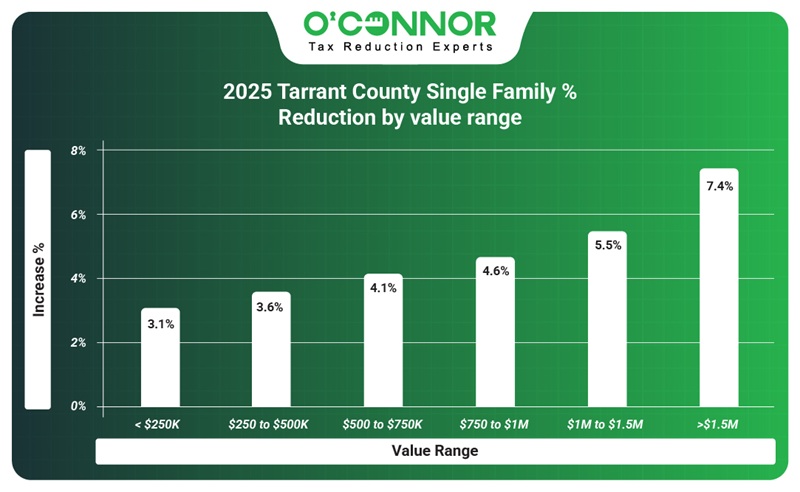
Homeowners across Tarrant County experienced a value spike of 1.6% in 2025. TAD instituted these figures despite evidence showing that homes were already overvalued. Taxpayers hit back in a big way, with informal property tax protests cutting assessed values by 4%. This not only wiped out the increases in value but also rolled them back from $220.49 billion to $211.60 billion. The largest beneficiaries were those of common homes worth under $200,000 or those between $250,000 and $500,000. These saved 3.1% and 3.6% respectively, while making up most of the property in Tarrant County. Homes worth over $1.5 million saw a value increase of 5.5%, but this was defeated by a reduction of 7.4%.

The trend of the average homeowner getting back great savings on appeals is evidenced further when homes are looked at by size. The two largest blocks of homes, those under 2,000 square feet and those between 2,000 and 3,999 square feet, got back 3.3% and 4% respectively. This shifted the total value down by a combined $6.96 billion. While high-end properties did not have the numbers of common homes, they did get huge benefits from appeals as well. The largest homes saved 10.4% with protests, after previously being raised by 10.8%. Homes in the middle saved greatly in both percentages and in total value reduced.
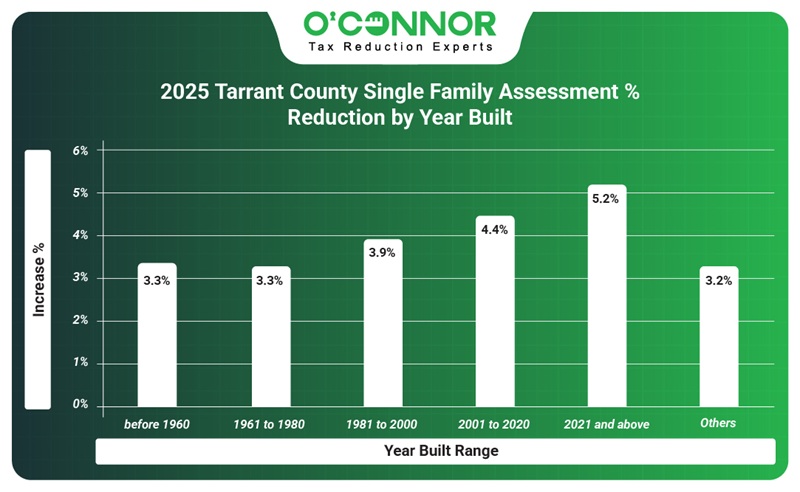
38% of all housing value in Tarrant County was built between 2001 and 2020, a total of $83.15 billion. Homes built between 1981 and 2000 were in the No.2 slot with $63.41 billion. Thanks to appeals, these saw reductions of 4.4% and 3.9%, representing the biggest chunk of savings. No matter the age; however, every home saw excellent reductions. New construction saw a reduction of 5.2%, which was the highest percentage. New construction had been assessed at 28.3% higher, so this was slowed down somewhat by the appeals process, with more sure to come in the ARB stage.
Property Appeals Help Counter 25.3% Commercial Value Spike
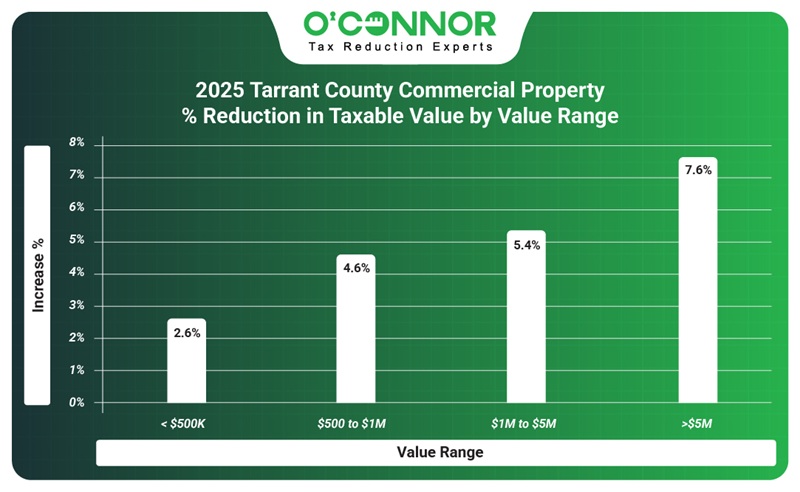
While homeowners saw a 1.6% rise in value, business owners were handed an astounding increase of 25.3%. This represented a rise of $14.40 billion in taxable value. Of the total $71.40 billion in value, $56.22 billion came from commercial property worth over $5 million. Preliminary tax protests were able to cut 7% from the total, including 7.6% from the largest businesses. Tarrant County has seen $5.18 billion cut from the commercial value so far, and much more can be expected to come down in the next few months with ARB appeals. It is typical for commercial property to go to the ARB, so this is all part of the process.
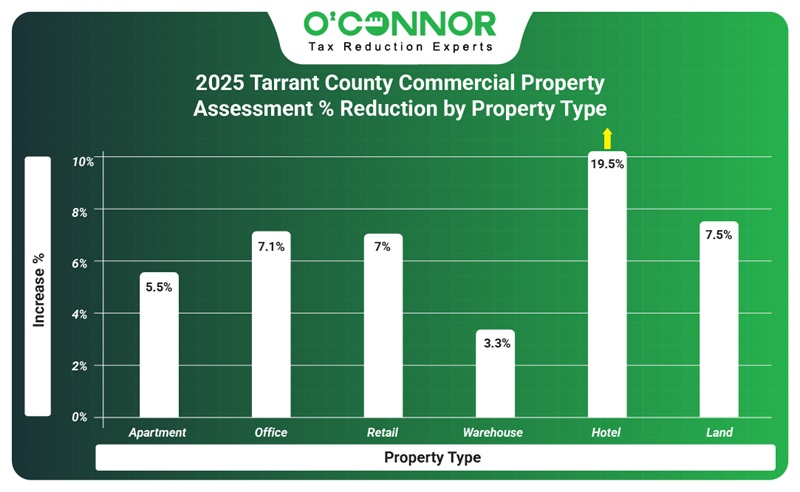
All Tarrant County commercial property saw an increase, but hotels saw the most with a giant bump of 43.3%, an increase of $1.54 billion. This was countered by the most aggressive of tax appeals, which managed a reduction of 19.5%. Apartments represent the largest block of taxable value and were initially increased by 25.3%, a gain of $8.16 billion. Informal protests were able to net a reduction of 5.5%, getting back $2.26 billion. Offices were in the No. 2 spot and achieved a reduction of 7.1%. While all of these appeals have cut into the explosive growth, there is still a ways to go in the ARB and even lawsuit stages.
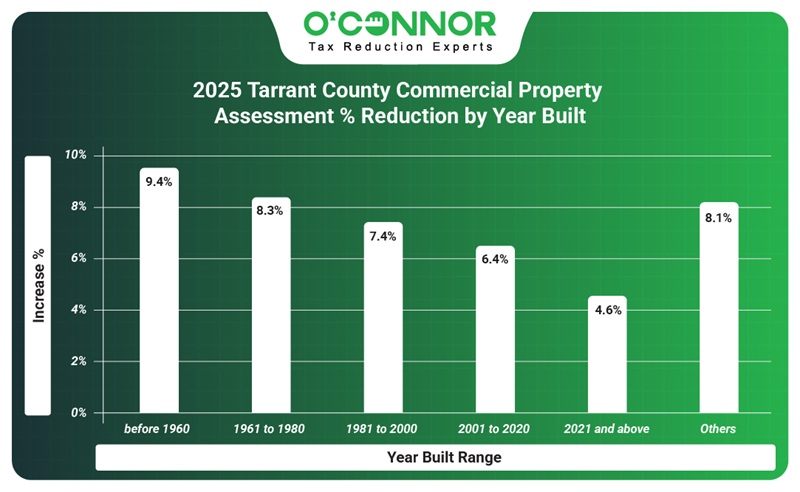
Like homes, the biggest chunk of commercial value was built between 2001 and 2020, to the tune of 36%. Totaling $26.30 billion, this timeframe experienced a reduction of 6.4% thanks to appeals, going down in value to $24.61 billion. Commercial properties built between 1981 and 2000 saw growth of 23.4% according to TAD, gaining $4.03 billion, the largest increase. This was likewise reduced somewhat by appeals, for a drop of 7.4%. New construction already accounts for 10% of all commercial property value, thanks to a massive spike of 60.8%. Diligent appeals were able to cut this by a paltry 4.6%, though this still represents significant taxable value.
Small Victories Against Soaring Apartment Values in Tarrant County
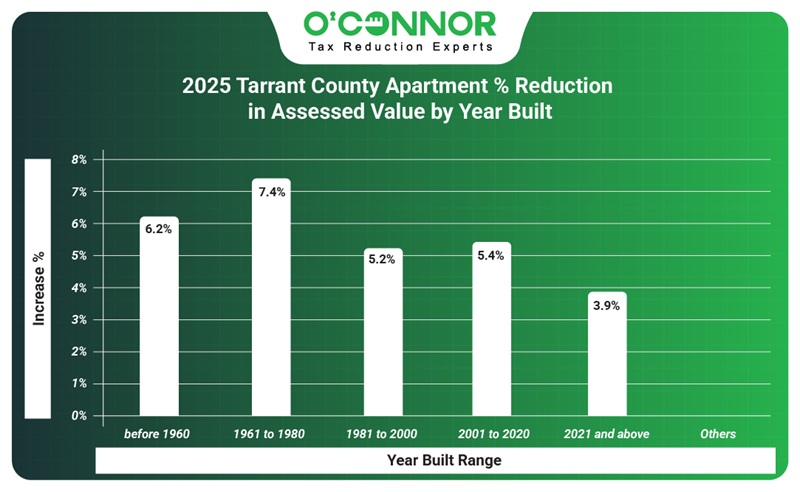
While all properties contributed to the record commercial increases, apartments were responsible for the most. Being the largest property type before the surge, the sudden increase of 25.3% meant adding $8.16 to the total. 36% of apartment value was built between 2001 and 2020, while 31% was built between 1981 and 2000. These categories each gained over $2 billion in value. When it came to reductions, these categories saw reductions of 5.2% and 5.4% respectively. New construction was hammered with an increase of 68%, while appeals were able to stop some of the bleeding with a reduction of 3.9%.

TAD only breaks apartments down into three subtypes, so it is hard to narrow down exactly how the value of multifamily residences is built. Generic apartments, to no surprise, accounted for $39.54 billion of the total, before being reduced to $37.34 billion thanks to a protest reduction of 5.5%. High-rise apartments came in a very distant second but were able to land a reduction of 6.9%. Low-income housing totaled only $198.88 million, though it still managed a savings of 5%.
Tarrant County Offices Strike Back Against an Increase of 19.1%
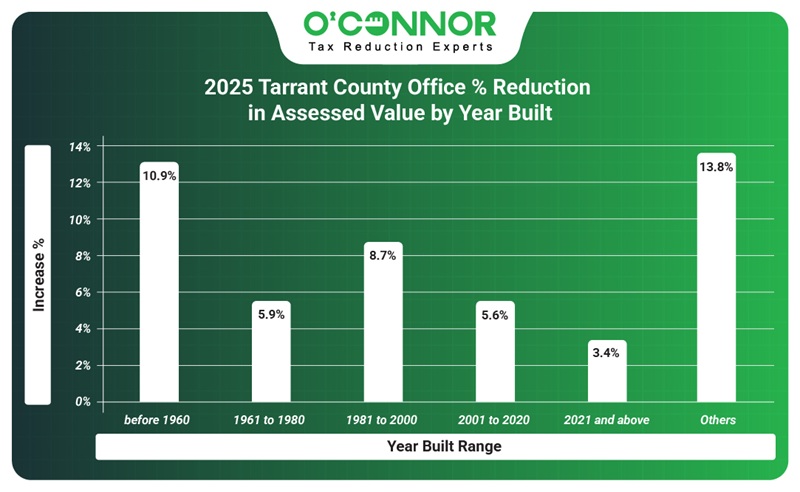
Offices are the second-most valuable commercial property in Tarrant County, totaling $10.78 billion. 43% of their value was built between 2001 and 2020, while 33% was built between 1981 and 2000. It was the increases in these categories that drove the value of all apartments up. Initial property tax appeals found fertile ground with these categories and managed to land reductions of 5.6% and 8.7% respectively, being the biggest contributors to an overall reduction of 7.1% for offices. The oldest apartments saw a reduction of 10.9%, while new construction managed 3.4%. These two categories had previously suffered the largest increases by TAD when it comes to pure percentage.
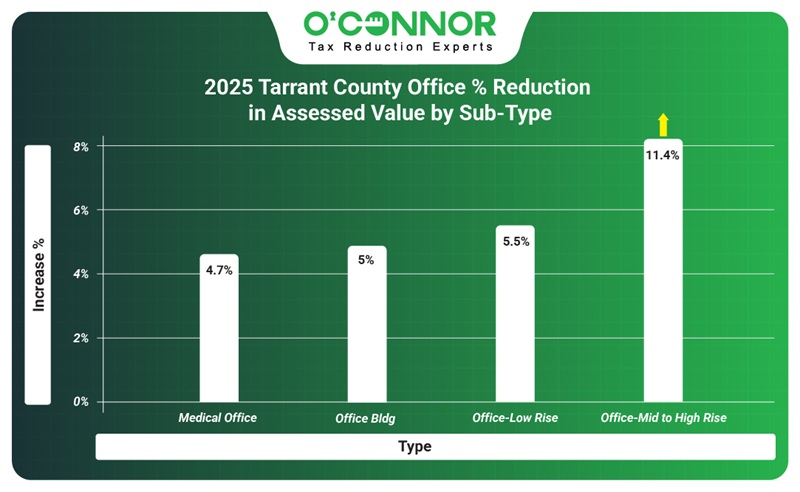
Like apartments, offices have only been given generic subtypes by TAD, though these are at least more informative. Low-rise offices were in the top spot with $4.76 billion, before receiving an appellate reduction of 5.5%. High-rise offices saved the most with 11.4%, bringing their new total to $3.18 billion. Medical offices were in third place with a reduced total of $2.41 billion. Miscellaneous office buildings were cut from $1.03 billion to $978.51 million.
Retail Taxable Value Protested Down 7% After Record Increase
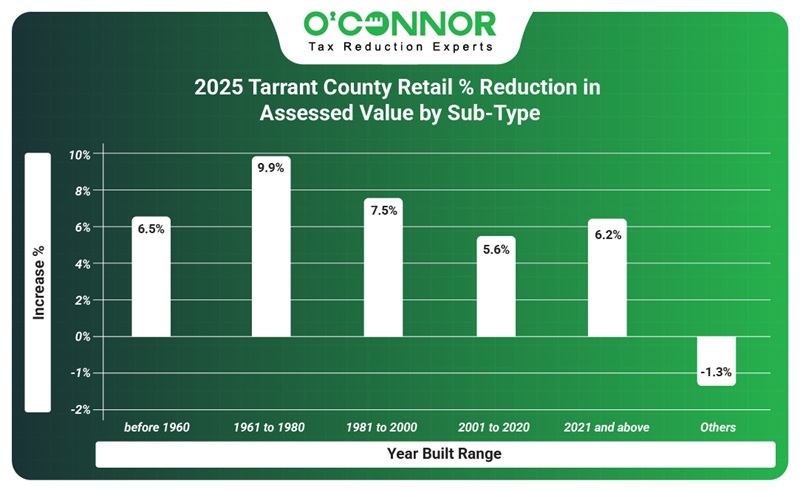
Retail properties saw their taxable value increase by 31.1% in 2025, which represents a staggering jump in tax burden. As they account for 36% and 32% of all value, this increase was felt most keenly by those retail spaces built between 1981 and 2000 and those built between 2001 and 2020. When the first round of appeals occurred, these categories saw the most benefit, with 7.5% and 5.6% respectively. New construction and the oldest retail buildings also got something of a reprieve, thanks to reductions of 6.2% and 6.5%.
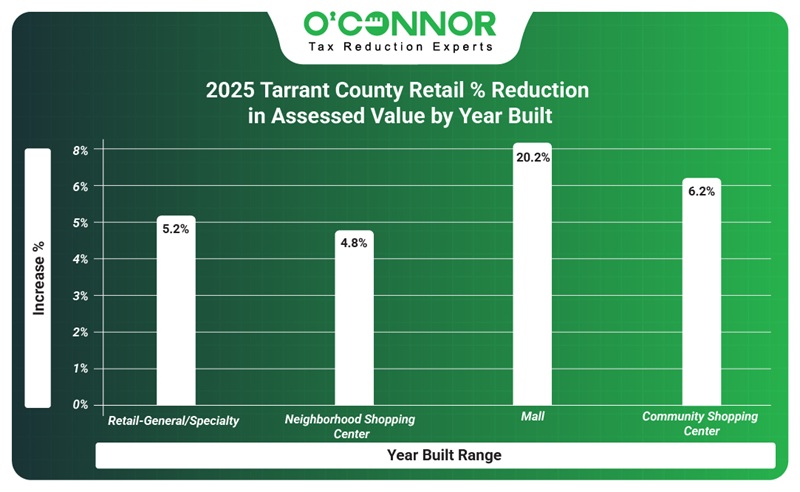
Unlike other commercial properties, TAD supplies good subtypes for retail spaces. Making up just under half of all value, neighborhood shopping centers were able to earn a reduction of 4.8% on their inflated valuation. On the opposite end of the spectrum, malls were the least valuable of commercial properties but nabbed an impressive 20.2% in savings. The second place community shopping center managed 6.2% in protested reductions, while retail-general saw a cut of 5.2%.
Tarrant County Warehouses See Good Results

Warehouses saw the smallest increase of all commercial property, being the recipient of an 18% increase by TAD. While this would be seen as catastrophic in most areas of Texas, this was something of a break for the warehouses of Tarrant County. 43% of all warehouse value was built in the years between 2001 and 2020, a total of $653.52 million. When the first round of appeals was completed, these warehouses had notched the largest batch of savings with 5.2%. Warehouses built from 1981 to 2000 were the No. 2 category and also had the second-highest reduction with 2.9%. New construction already accounted for 16% of all value and managed a small cut of 1.5%.
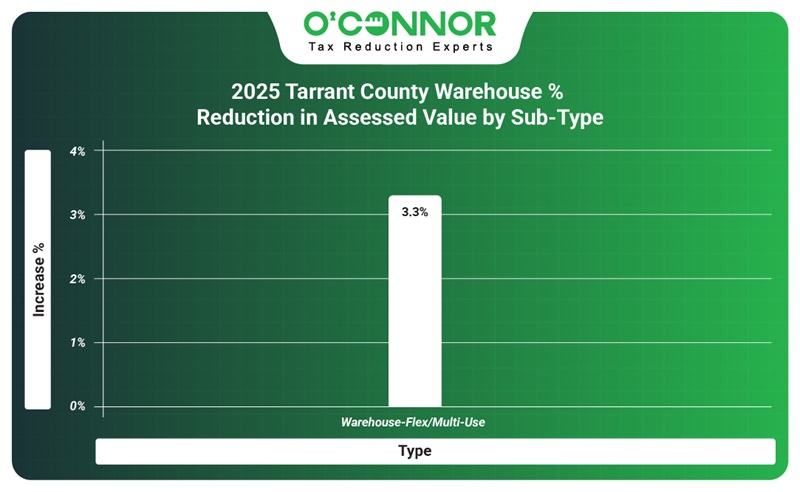
TAD does not break down warehouses by any subtypes, instead reporting them as one monolithic block. While we gleam no new information from this, we can point out that the total taxable value of warehouses fell from $1.65 billion to $1.60 billion, a reduction of 3.3%.
Tarrant County Protests Roll Forwards
While Tarrant County has historically been somewhat reluctant to embrace property tax protests, that is no longer the case. Homeowners that did appeal not only saw recent value spikes erased, but were even able to reclaim some older value from the clutches of TAD. While commercial owners could not expect such a bounty, they were able to stop some of the bleeding inflicted by being handed an over 25% increase. With more ARB hearings on the horizon, some normalcy could be coming for those properties as well.
From homes to businesses, Tarrant County has become an unlikely proving ground for property tax appeals. The people of Fort Worth and the surrounding area let TAD run amok for too long and are finally seeing the errors of their ways. Informal appeals alone have saved billions in value, and this will only be improved upon by ARB hearings and even lawsuits if they are needed.
Join O’Connor and ensure that your property taxes and values are protested every year. Looking at the results, protests and appeals work. O’Connor is based in Texas, and we have been doing appeals for over 50 years. We helped over 185,000 clients in 2024 and are looking forward to helping more in 2025. There is never any fee for signing up with us, and you will only ever be billed if we are able to lower your taxes.

